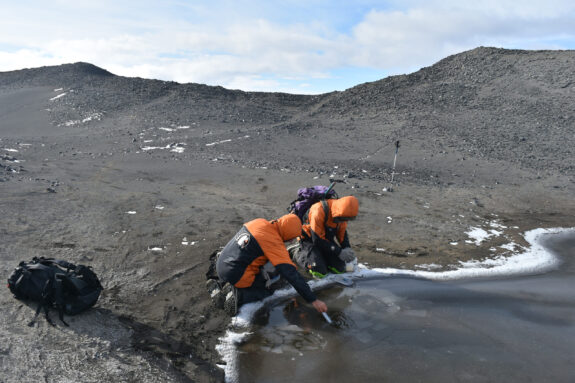Today, NASA’s Perseverance lifted off from Cape Canaveral’s Launch Complex 41 in the early morning light, bound for Mars. In February 2021, the Mars 2020 rover and a drone helicopter will arrive at the red planet. Over the next year, they will examine the planet’s surface, starting with Jezero Crater, a former river delta and lake, for signs of former habitability and biosignatures in rocks. This is when the Mars Sample Return campaign begins with MIT EAPS Professor of geobiology and member of the mission’s Project Science Group Tanja Bosak and professor of planetary sciences Ben Weiss. They are part of an elite 10-person Return Sample Selection team, who will examine results from the rover’s analysis of the topography, elemental composition of sediments, and the compounds present. The group will consider rock textures and compositions and will decide what samples are the most promising to core — for science now and for generations to come. Within the decade (aiming for 2026), NASA and the European Space Agency (ESA) will work together on two follow-up missions to retrieve the cached cores left on Mars. After which, some of the most important analyses will begin, back on Earth.
NASA has launched the most ambitious Mars rover ever built: here’s what happens next (Nature)
Jezero means ‘lake’ in several Slavic languages. More than 3.8 billion years ago, a river flowed into the 45-kilometre-wide crater, and lake waters filled it. Images suggest that along the crater’s rim, carbonate minerals settled out and hardened into rock. That’s exciting because on Earth, ancient carbonate rocks hold some of the oldest known evidence of life, including fossilized bacterial mats known as stromatolites.
If Martian life ever existed, Jezero’s carbonates are a good place to look for it. “We’ve not explored an environment like this before,” says Tanja Bosak, a geobiologist at the Massachusetts Institute of Technology in Cambridge who is working on the mission. Evidence of life could come in the form of actual fossils, or in chemical or geological signatures of organisms that once lived in the rocks.
The long road to returning first-ever samples from Mars (CNN)
First, Perseverance will explore the river delta, followed by the crater rim, and eventually, “drive out of the crater and explore the wonderland of the earliest history of Mars,” according to Benjamin Weiss, a professor of planetary sciences at the Massachusetts Institute of Technology and one of the Returned Sample scientists for Perseverance. Weiss is on a team that will make determinations of where and when to collect samples — and hopes to analyze them once they return to Earth. …
Weiss has worked on research using the samples collected during the latter years of the Apollo program. Some have remained sealed for 50 years until new technology and instruments were developed to help better understand them.
Weiss wants the same approach to be taken regarding samples from Mars.
“We can’t get trapped by selecting samples just based on what current instruments can measure,” Weiss said. “We can’t conceive what instruments can be like 100 years from now. But if we sample from places that may be habitable, that will keep them interesting for years to come.”
Will We Recognize Life on Mars When We See It? (WIRED):
“With microbes, you never really see only a single cell. It’s always a macroscopic community,” says Bosak. “The fundamental interactions between organic matter and minerals should be the same on Earth and Mars, so we’ll use cameras to look for these different kinds of microbial shapes.” …
Of course there’s the possibility that Perseverance turns up empty-handed in its search for biosignatures on Mars. But that doesn’t necessarily mean the planet is devoid of life, says Sarah Stewart Johnson, a planetary scientist at Georgetown University [and MIT EAPS alum]. It might just mean that life on other planets looks different from life on our own. But how can you find something if you don’t know what you’re looking for? …
Instead, Johnson and her colleagues are looking at complexity as a process. In other words, how many different ‘steps’ does it take to create a given molecule, where each step is something like adding a new type of molecular bond? Their research suggests that there is a threshold of complexity at around 14 or 15 steps; above that, any molecule is almost certain to have been formed by a biological process.
NASA’s new Mars rover is about to embark on a hunt for ancient alien life (The Verge):
Perseverance is just the first — extremely complicated — step in that sample return process. If successful, Perseverance will neatly package dozens of samples of the Martian surface that may one day see Earth. They may tell us if life existed on Mars or if it’s always been a barren planet. “This is really a unique — really a once-in-a-lifetime — opportunity to get samples from a known location on Mars,” Tanja Bosak, a professor of geobiology at MIT who is a participating scientist on the mission, tells The Verge. …
Ultimately, a decision to drill will take days to weeks of discussion, with scientists weighing thousands of different factors. “Each sample will be incredibly valuable, and really one of its kind,” says Bosak, who is part of the team of scientists making the decision on where to drill. “But while valuable, we can be paralyzed also by: ‘Oh is this as valuable as something around the corner could be?’ We’re still working out what exactly is good enough, because maybe around the corner is worse.”
NASA rover Perseverance will prowl ancient lake bed on Mars for signs of life (The Washington Post):
Even if the mission doesn’t find signs of life, it might detect “some kind of prebiotic phase of life,” said Benjamin Weiss, a Massachusetts Institute of Technology professor who is part of the Perseverance science team.
“If we could bring back a fossil record, a rock record, some kind of geological samples, that have some record of that prebiotic phase of the evolution of life, that would arguably be as exciting, or arguably more exciting, than finding life,” Weiss said.
Bold space mission to bring back rocks from Mars takes shape (Science Magazine):
And if Jezero’s clays show no signs of past life, scientists will want to know why. “Was it because it wasn’t habitable, or because life couldn’t get started?” asks Benjamin Weiss, a planetary scientist at the Massachusetts Institute of Technology in Cambridge. Scientists believe Mars lost its magnetic field billions of years ago as its core cooled, allowing its atmosphere to escape and leaving its surface cold, dry, and exposed to radiation from space. By dating different samples and measuring their fossil magnetism and the conditions in which they formed, scientists can test whether this theory is true—and, if so, whether the martian environment grew inhospitable so early that life could never get started.
As the rover forges a path up the delta, the fine mudstone will give way to rough sandstone. The team will keep an eye out for exposures of opal-like rocks that have recently been spotted from space. Opal forms from a solution of silica and water, and on Earth the deposits are classic fossil-hunting spots. That’s because the mineral creeps into organic layers and preserves fossil structures, Bosak says. “That’s where we find the most beautifully preserved microbial mats.” The rover’s cameras will search for such structures, but Bosak doubts they will be seen—even on Earth, they are not often apparent until polished in the lab.
The sand grains, washed in by the long-lost river, could also say something about what caused Mars’s early warmth—whether steady or intermittent—to dissipate after the delta formed. Some of the sand grains, eroded from volcanic rocks, will contain radioactive isotopes that make it possible to date them. Scientists on Earth will also examine certain minerals to look for the frozen imprint of a magnetic field. Mars is believed to have had a magnetic field early in its history, generated by a molten dynamo in the planet’s interior. The field would have failed as the dynamo cooled and shut down, and some believe that explains Mars’s radical change in climate. A weakening field could have allowed charged particles from the Sun to erode the planet’s once-thick atmosphere. Water would have escaped to space, making the planet colder and drier. Magnetic signatures teased out of the sand grains could show whether the decline of the field preceded—and perhaps caused—the climate change.
Story Image: NASA Perseverance launches from Cape Canaveral on the morning of July 30th. Credit: Natalia Guerrero, MIT Kavli for MIT EAPS



